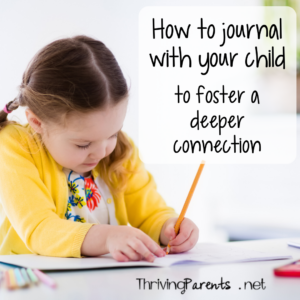
In my post about how to have a deeper connection with your child, especially when you have more than one, I detail how I use a journal to write back and forth to the kids.
I wanted to write a little more about what this looks like. I started this as a way to encourage writing and to be able to share some thoughts and ideas. I feel like I have a really open relationship with our kids but wanted them to know the journal was also a safe place for them to write about how they feel without worrying about hurting anyone’s feelings or having to say anything out loud.
Here’s what I wrote in the original post:
Explained to your child that you will be using a journal to write back and forth to each other. They can write to you about anything and no one else will read it. They can tell you things, ask you any questions, draw a picture, or just answer questions you ask of them. When they’re done writing, they put the journal under your pillow or any other place that you designate. When you write back to them, you’ll place it under their pillow. It almost feels like a secret club.
This is an activity deeply rooted in connection. As time goes on you’ll see your child open up more and more, as long as it remains a judgment free zone for them. You can start this at any age and here’s how.
Toddlers
What this looks like:
Working together:
You can use the notebook to draw a picture together. Either you can take turns adding things to the picture so when you’re done you have an entire scenery, or you can each take a side of the page and draw next to each other.
Working alone:
If your child needs more space (meaning when they work next to you, they have their elbows splayed out and take up all the room) you can use a notebook where you take turns drawing your own picture, alternating pages. You can slip the notebooks under each other’s pillows (or under the door) to look at the picture, draw a picture, and then send it back. This would be a great quiet time activity, especially if your child is on a nap strike or stopping their naps.
Preschoolers
What this looks like:
Working together:
You can write questions in the journal and write their response down for them. You can encourage them to ask you questions too because most kids will just respond to the questions without asking their own. You can also do the drawing activity I listed above in the toddler section. That activity isn’t just limited to toddlers.
Working alone:
You can ask questions and have your child draw their answer. You can also have them look around the house for words so see how they’re spelled. For example, if you ask them, “What is your favorite color?” they can go find the crayons to see how blue is spelled. You could also write the questions and have them dictate the answers to another person like a sibling, parent, or grandparent. That other person can do the writing for them. As the child gets older, the journal can become more private.
School age
What this looks like:
In the early years (Kindergarten, 1st and 2nd grades), your children may do a combination of drawing and writing to respond to you. It is most important to NEVER, EVER, EVER correct their spelling. Getting their ideas out of their head onto paper is so much more important than mechanics. If you correct spelling or fix mistakes you’ll suck all the fun out of this activity and I promise you it’ll create distance between you and not help foster more connection. If there’s a time where you can’t understand or read what they wrote, you can ask them. Take turns writing back and forth. You’ll need to start by asking a question almost every time it’s your turn. It took a while for our own girls to ask questions or mention anything beyond answering my questions for them.
Tweens and Teens
What this looks like:
This is a time to try to ask some more thought provoking questions. You can alternate between some questions that get them thinking about their values and what they would do in certain situations with some questions about their favorite foods and ice cream flavor. You want this journal to be a safe place for them to share with you the ordinary and the extraordinary. Don’t let them know you take offense to anything they share or they won’t be willing to be open to you again. With this age group you also need to let them know that what they write is confidential unless you feel that someone is in danger. Then you’ll both need to decide how to seek help and tell someone. – but you’ll support them. This is for the times they tell you a friend is self-harming or contemplating suicide. By telling them this ahead of time, it lets them know where you stand. They are still free to share these things with you but it’ll also put you both on the same side should you need to help save someone’s life. These years are so precious and fragile and they’ll need your support the most then. One thing to be prepared for is the questions they ask YOU. They may ask you some hard and really personal questions. If you answer them, be as honest as you can without making your answer sound too much like a lesson. If you don’t want to answer them, tell them that you’ve decided that’s not a question you want to answer and why (it’s too personal, etc) and then ask them to ask another one.
Important things to note:
If your child is a reluctant writer than you may do better with a mom & me journal, a dad & me journal, or a kid journal that you work on together. They even sell journals that can be done between a child and another adult, like a grandparent, aunt, uncle, Godparent, etc.
At any age, if your child still wants to do a drawing that’s fine too. One of our kids is in love with doodles and art and she draws me photos all the time. The point is you want to make this activity child centered, which means you want to do it in a way that interests them. If they’re not interested in it, they won’t do it. This also shouldn’t be a power struggle. They don’t have to do it and there’s no time limit. You just know it’s your turn because it’s been placed under your pillow.
To some people this may sound like a daunting task. It doesn’t have to be! Do it when you can, when you think you need to, or if your child has been a bit distant.
Want to learn more about how to connect with your kids and understand negative behaviors? Take a look at the parenting classes I offer. Next week I’ll be teaching Top 10 Ways to Get Your Kids to Listen & Cooperate.
xoxo
–k
Here are a list of Random Acts of Kindness that kids can do (it includes a printable!)
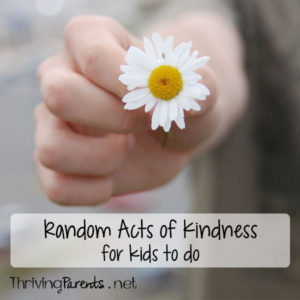
Teaching our kids to do Random Acts of Kindness teaches them empathy, compassion, and thoughtfulness. Here’s a printable list of activities your children can do for others and the people who would be great recipients.
3 ways to connect with your kids individually
Kristina Grum is a Certified Parent Educator who has over a decade of experience working with children, including being a classroom teacher. She currently teaches parenting classes in her local area and writes about shifting parenthood from barely surviving to thriving.
Pin this to save it for later!
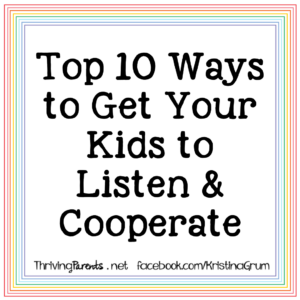

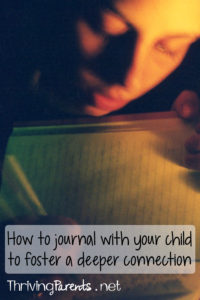
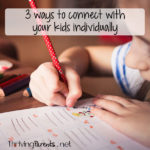
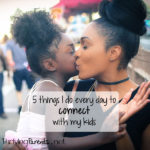

Thank you for this!!!
I am going to attempt this with my daughter, his father and I are separating and I'm sure that it will be an excellent way for her to communicate any big feelings or fears that she has.
we tried this with the teenager for a while with mixed results. Will try again with her younger sister, as it really is a great idea
Do you only keep your messages positive or do you ever address concerns/disappointments with choices that they made? Or discuss any issues with them?
Hi there! I do keep them positive. The journal is used as a way to get a better connection with my child so I try to make it a safe place where I can learn more about them and they can feel free to share or ask me anything they want. I think if it becomes a place where there’s criticism or negativity, they’d stop using it.